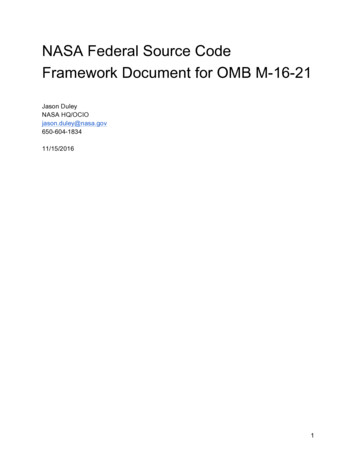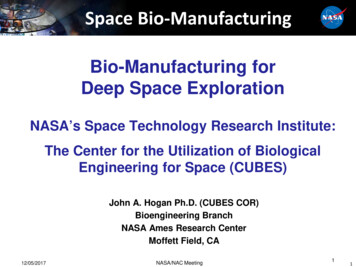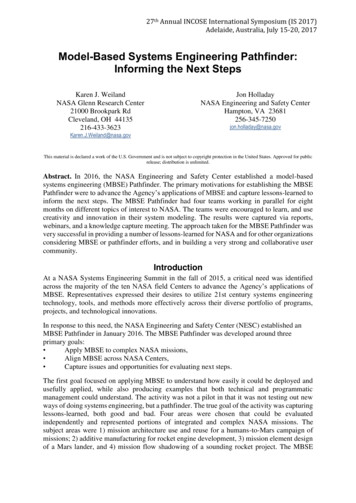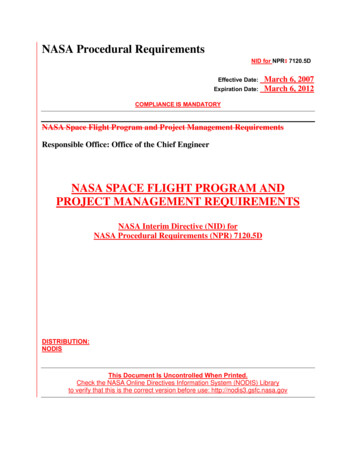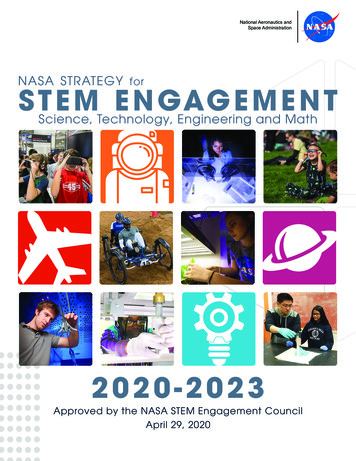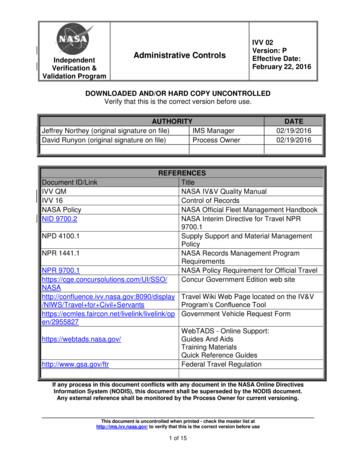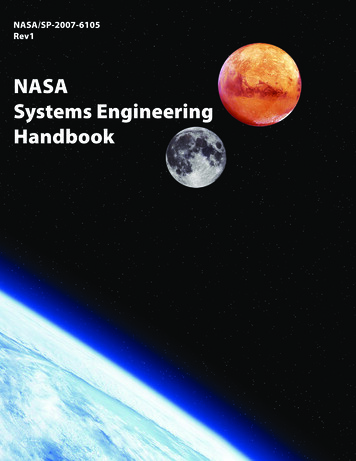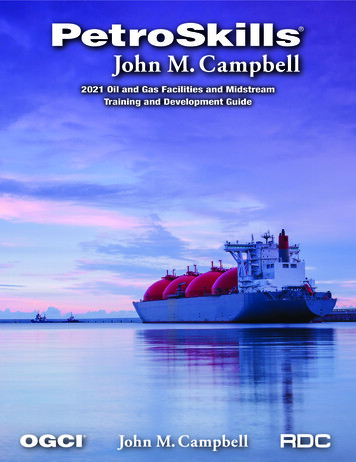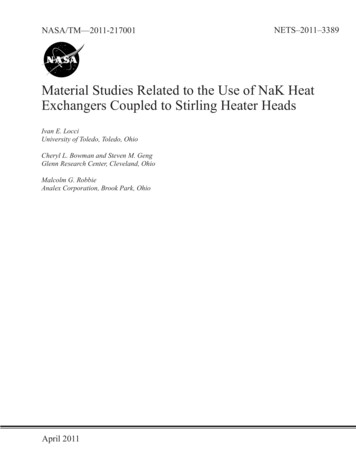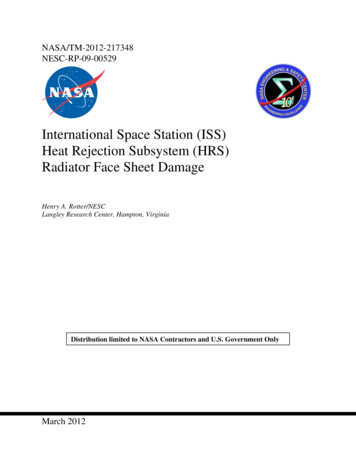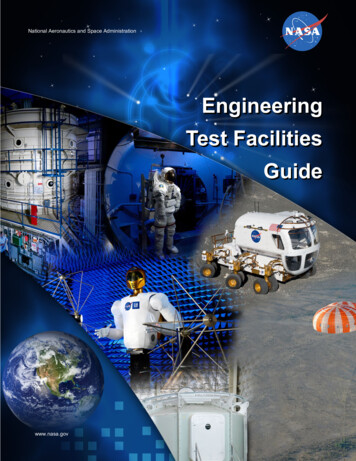
Transcription
National Aeronautics and Space AdministrationEngineeringTest FacilitiesGuidewww.nasa.gov
Welcome to the Johnson Space CenterJohnson Space Center's engineering teams have successfully accomplished many of thenation's most complex human spaceflight-related projects. The Center has created and refinedinnovative spaceflight research and development techniques that encompass all phases ofhuman spaceflight—from highly developed design through fabrication and operationsprocesses. Through this ongoing refinement, Johnson Space Center continues to expand itsworld-class capabilities, which include an expert work force, natural infrastructure, uniquefacilities, flexible project management, and a proven operating system.2
Table of ContentsOverview .4Doing Business with Us .5Human Space Vehicle Systems .6Spacecraft Communications . 7Structures and Materials . 12Integrated Power . 16Models, Simulation, and Software. 18Thermal Management . 23Mechanical Separation Systems . 24Crew Survival . 25Flight Crew Equipment . 26Environmental Control and Life Support Systems . 27Water Recovery Systems . 28Air Revitalization Systems . 30Extravehicular Activity (EVA) Systems . 31Space Suit Design and Development. 31EVA Systems Testing . 33Integrated Environment Testing . 35Launch Environment . 36Space Environment . 41Reentry Environment . 49Electromagnetic Interference/Compatibility Environment . 51Flight Design . 52Guidance, Navigation, and Control . 53Rendezvous, Proximity, and Docking. 55Flight Mechanics . 56Entry, Descent, and Landing . 57Aerodynamics . 58Robotics . 59Acronyms . 61Facility Index . 63http://jsceng.nasa.gov3
OverviewThe Johnson Space Center (JSC) is uniquely positioned to provide engineering design,development, and testing for spaceflight vehicles and systems. Capability is available in theareas of human space vehicle systems, life support systems and environmental control, flightdesign, integrated environment testing, and robotics. This guide describes the test andevaluation capabilities that are currently maintained in active status. This guide is dividedinto six technical categories. These categories are represented by the color schemepresented below.Human Space Vehicle SystemsIntegrated Environment TestingSpacecraft CommunicationsLaunch EnvironmentStructures and MaterialsSpace EnvironmentIntegrated PowerReentry EnvironmentModels, Simulation, and SoftwareElectromagnetic Interference/CompatibilityThermal ManagementMechanical Separation SystemsCrew SurvivalFlight DesignFlight Crew EquipmentGuidance, Navigation, and ControlRendezvous, Proximity, and DockingEnvironmental Control and Life andSupport SystemsFlight MechanicsWater Recovery SystemsEntry, Descent, and LandingAir Revitalization SystemsAerodynamicsExtravehicular Activity (EVA)SystemsRoboticsSpace Suit Design and DevelopmentTechnology DevelopmentPortable Life Support SystemsHighly Dexterous ManipulatorsEVA Systems Testinghttp://jsceng.nasa.gov4
Doing Business With UsWe have developed customer-friendly agreements to streamline business relationshipsand are eager to share our unique facilities and expertise with new customers. We inviteyour inquiries regarding application or adaptation of our capabilities to satisfy your specialrequirements. Briefings on general or specific subjects of mutual interest can be arrangedat JSC or at your business site.There are two paths established for obtaining our services, depending on your organizationtype. The steps below summarize the typical process for planning and conducting testactivities within the Engineering Directorate at JSC.Commercial Partners1. Commercial Partner contacts one of the JSC representatives listed below to inquireabout our services.2. JSC will provide an initial cost and schedule estimate.3. If the estimated cost and schedule are acceptable, a Space Act Agreement willbe drafted.Note: Commercial Partners may be able to use an existing umbrella agreement.4. Once the agreement is signed, funding must be submitted to the NASA JSC FinanceOffice in order to proceed with work.Government Partners1. Government Partner contacts one of the JSC representatives listed below to inquireabout our services.2. JSC will provide an initial cost and schedule estimate.3. If the estimated cost and schedule are acceptable, an interagency agreement orreimbursable agreement will be drafted.4. Once the agreement is signed, a valid purchase request, such as a MilitaryInterdepartmental Purchase Agreement, must be submitted by an authorizedcertifying officer.Contact InformationAssociate Director, JSC EngineeringPhone: 281-483-8991Email: jsc-ea-partnerships@mail.nasa.govFor assistance or additional information about JSC, please visit: http://jsceng.nasa.govhttp://jsceng.nasa.gov5
Human Space Vehicle SystemsJSC provides combined expertise in structural design, analysis, testing, dynamic loadsanalysis, and materials evaluations for space-faring vehicles. Specialty areas includereliable pyrotechnics, power systems and power quality, fluids management, batteryperformance, imagery analysis, micrometeoroid debris analysis and design, cockpitdesign, radiation-hardened avionics, thermal control systems, crew survivability, andreliable software.Spacecraft CommunicationsIntegrated PowerStructures and MaterialsModeling and SimulationHuman Space Vehicle Systemshttp://jsceng.nasa.gov6
Human Space Vehicle SystemsSpacecraft CommunicationsSpace vehicle communications systems are unlike other spacecraft systems, because theyinterface not only with other equipment on the space vehicle but also with externalequipment that is remotely located. JSC has expertise and unique facilities in which multielement spacecraft communications systems are interfaced with relay satellites and groundelements for end-to-end testing in a controlled Radio Frequency (RF) environment. JSCalso provides for the design, development, and testing of spacecraft communicationsystems, including evaluation of the electromagnetic radiation properties of antennas andother radiating objects.Antenna/RF Design and TestingServices ProvidedJSC provides expertise in the design,development, and manufacture ofantennas and RF equipment. JSC canconduct antenna and scattering tests andmeasurements and providecomputational electromagnetic analysis.Antenna performance characterizationMeasurement of near-and-far-field antennaradiation distribution patternsRadar cross-section calculationsDesign and development of microwavedevices and antennasGeneral three-dimensional (3-D) frequencydomain electromagnetic analysisWireless and Radio FrequencyIdentification (WRFID) LaboratoryAntenna coupling analysisThe WRFID Laboratory can facilitate thedesign, development, testing, and analysis ofRadio Frequency Identification (RFID) andother wireless technologies for spaceapplications. The laboratory provides for thedevelopment of antennas and RF circuits andthe testing of antenna, RF circuits, and RFcables using various RF test equipment.Verification of microwave and antennameasurementsComputational Electromagnetics (CEM)LaboratoryThe CEM Laboratory is used for full-wave,frequency domain electromagnetic simulations.The laboratory houses a computer cluster thatcurrently contains 476 processors and 1.95terabyte of random access memory. The CEMuses software called GEMINI (GeneralizedElectroMagnetic INteractIons), which wasdeveloped at JSC.Computational Electromagnetics LaboratoryHuman Space Vehicle Systems—Spacecraft Communicationshttp://jsceng.nasa.gov7
Human Space Vehicle SystemsAntenna Test Facility (ATF)The ATF is used to test antenna radiationdistribution pattern performance for spaceflightapplications in electromagnetic environmentsconditioned to simulate free space. Thefrequency range of this activity spans from200 MHz to 40 GHz. The antenna ranges areused to acquire radiation performance data bytaking radiation pattern measurements. The ATFhas one anechoic chamber and an outdoorantenna range. The anechoic chamber housestwo antenna test facilities: the Far-Field TestFacility and the Near-Field Test Facility.Antenna Test FacilityAntenna Test Facility SpecificationsFacilityFar-Field TestFacilityNear-Field TestFacilityOutdoor AntennaRangeParameterValueFunction/frequency rangeMeasures far-field antenna radiation distribution patternsand principal plane cuts; 200 MHz to 40 GHz frequencyDimensionsFlared horn shape (tapered), 150 ft long with crosssection approximately 40 ft by 40 ftRange lengthApproximately 115 ft from tip of apex to Antenna UnderTest (AUT)Antenna mountingSingle positioner or dual positionerLoad capabilitySingle positioner can handle 600 lb; dual positioner canhandle 1,200 lbMaximum mockup size28 ft in length on dual positionerFunction/frequency rangeMeasures near-field antenna patterns using a raster can;350 MHz to 4 GHz frequency rangeAntenna mountingHydraulic cylinder – AUT fixed in vertical position duringtest; dual tower positioner – AUT not fixedScanning plane38 ft by 38 ftMaximum antenna size28 ft in length on dual tower; 30 ft in diameter onhydraulic cylinderFunction/frequency rangeMeasures far-field radiation principal plane cuts;200 MHz to 26.5 GHz frequency rangeRange length 180 ft from transmit antenna device under testHuman Space Vehicle Systems—Spacecraft Communicationshttp://jsceng.nasa.gov8
Human Space Vehicle SystemsCommunication and Tracking SystemsJSC provides system-level performance analysis and testing, internal/external interfacecompatibility, end-to-end system integration, and integrity of communications and tracking,network, command and data handling, and instrumentation systems.Services ProvidedSystem analysis and integration–Dynamic and static link budget and RFcoverage analysis–Multipath/differentiation/reflection analysis–Radiation keepout zone/mask analyses–Signal propagation effects–Systems/performance trade studies–IP communications stack–Traffic model/timing/delaysRF spectrum engineeringHD Motion Imaging LaboratoryCommunication systems simulation and modelingCommunication systems testbeds (e.g., PROPSim, IP testbed, STK, DECAT, FEKO, XGtd,Wireless InSite, MATLAB/Simulink, QualNet, OPNET)Communication Systems Simulation Laboratory (CSSL)The CSSL consists of state-of-the-art computer-aided design and analysis tools used to model andsimulate the performance of both proposed and actual spacecraft communication systems,subsystems, components, and parts. CSSL services include RF coverage and compatibility, endto-end communication system performance, system design and verification, signal analysis,network simulation, and anomaly resolution. The CSSL also supports JSC spectrummanagement activities.High-Definition (HD) Motion Imaging LaboratoryThe HD Motion Imaging Laboratory provides high-fidelity HD evaluation, analysis, and verificationtesting of spacecraft video, ground facilities processing equipment, and imaging systems. HDvideo signals from encoders, cameras, recorders, and other devices can be tested for comparisonor compliance with video standards, including quality, latency, and network performancespecifications. The laboratory is configured with complete flexibility and efficiency, yet providesperfect signal integrity with no loss or degradation throughout its data signal pathways.Global Positioning System Laboratory (GPSL)The GPSL is a design, development, testing, and evaluation facility that allows testing of GlobalPositioning System (GPS) equipment with live GPS satellite signals via rooftop antennas andantenna positioners.Human Space Vehicle Systems—Spacecraft Communicationshttp://jsceng.nasa.gov9
Human Space Vehicle SystemsElectronic Systems Test Laboratory (ESTL)The ESTL is a facilitywhere multi-elementcrewed spacecraftcommunications systemsare interfaced with relaysatellites and groundelements for end-to-endtesting in a controlled RFenvironment. This facilityis used for designevaluation, RF interfacecompatibility verification,and system performanceverification testing ofspacecraft RFcommunications systemsand their interfaces withexternal elements (e.g.,ground stations, relaysatellites, detachedpayloads). Space vehicle communications systems are unlike other spacecraft systems, becausethey interface not only with other equipment on the space vehicle but also with external equipmentthat is remotely located. The interface with the external equipment serves as the lone link betweenthe Earth-based elements and the space vehicles. Thus, communications verification testing of thelinks between the external elements and the equipment on a crewed or unmanned space vehicle orhigh-valued payload is essential for successful flights.Services ProvidedCommunication verification testing between relay satellites, ground terminals, and thespacecraft––Installation and testing of all International Space Station (ISS) RF S-band and Ku-bandcommunication equipmentThree antenna radomes for RF transmission/reception from an on-orbit spacecraft or a Trackingand Data Relay Satellite (TDRS)RF characterization testing for payloads, satellites, and other unmanned vehiclesRF anomaly resolution testbed—prelaunch, real-time, and postflightSupport of Tracking and Data Relay Satellite System (TDRSS) Network verification andvalidation tests, TDRS checkout, and TDRSS Network firmware checkoutsAnalysis model verificationUltra-high frequency, S-Band, Ku-Band, and Ka-Band RF spectrumHuman Space Vehicle Systems—Spacecraft Communicationshttp://jsceng.nasa.gov10
Human Space Vehicle SystemsSpacecraft Audio SystemsServices ProvidedUniform simulated acoustic environments for performance testing electroacoustic devicesUltra-low ambient acoustic noise environment for testing microphone performance andcharacterizing acoustic emission sourcesLow acoustic noise environment used for audio recording and subjective audioperformance testingAudio Development Laboratory (ADL)The ADL provides for the design, development, test, and evaluation of audio sound equipment.The laboratory houses a reverberation chamber, a quiet room, and an anechoic chamber. Thereverberation chamber provides uniformsimulated acoustic environments forperformance testing of electroacousticdevices, such as earphones with passivenoise attenuation and noise-cancelingmicrophones. The anechoic chamberprovides an ultra-low ambient acousticnoise environment for testing microphoneperformance and characterizing acousticemission sources. The quiet roomprovides a low acoustic noiseenvironment used for audio recording andsubjective audio performance testing.Robonaut 2 Testing in ADLADL SpecificationsFacilityADLFacility Size15 ft x 8 ftSound Pressure Level (SPL)125 dB SPL 30 to 500 Hz115 dB SPL 500 to 8 kHzHuman Space Vehicle Systems—Spacecraft Communicationshttp://jsceng.nasa.gov11
Human Space Vehicle SystemsStructures and MaterialsJSC provides state-of-the-art laboratories to develop and evaluate, under appropriatespace environmental conditions, structural, mechanical, and thermal concepts andmethods of analysis and testing for space vehicle applications. Capabilities include design,development, and testing of structures, mechanisms, thermal protection systems, passivethermal control systems, and mechanical systems for the advancement of technology andspace vehicle capabilities.Structures Test Laboratory (STL)STL SpecificationsThe STL is used for static load testing ofassemblies and components. Tests rangefrom mechanical properties testing ofmaterials to full-scale verification testing ofpayloads and spacecraft structures. JSC isequipped with a variety of hydraulic andelectromechanical load frames with maximumload capacities ranging from 10 to 220 kip.ParameterValueLoad capacityUp to 220,000 lbfActuator capacityUp to 150,000 lbfStroke range6 in. to 57 in.Temperature range–300 to 800 FServices ProvidedStatic and fatigue load testing using single ormultiple actuators up to 220,000 lb12 load frames––Tension and compression testingLoad or displacement controlCyclic testing up to 100 HzFracture mechanics property testing –automated da/dN testingTensile, lap shear, and compression testingof materials at low and elevatedtemperaturesFatigue/fracture coupon testsStructures Test – Orion Crew ModuleServo-controlled load applicationStructural Dynamics TestingJSC can perform a wide range of tests needed to evaluate all aspects of structuraldynamics, including vibration, vibroacoustics, modal characteristics, sound transmissionloss, and shock testing. These facilities can be used to perform test and evaluation of bothaerospace and nonaerospace hardware. For more information about our structuraldynamics testing capabilities, see Launch Environment (page 36).Human Space Vehicle Systems—Structures and Materialshttp://jsceng.nasa.gov12
Human Space Vehicle SystemsMaterials AnalysisOur materials laboratories provide analyticalcapabilities used in the analysis and evolutionof spaceflight hardware. Test and evaluationcapabilities include metallography, materialproperties testing, microscopy, environmentaltesting, Nondestructive Evaluation (NDE), andanalytical chemistry.Nondestructive EvaluationAnalytical Chemistry LaboratoryRadiographic Testing (RT)Analytical Chemistry Computed Tomography (CT) Digital RTChemical analysis Standard film RT–Fourier transform infrared spectrometryUltrasonic Testing (UT)–Pyrolysis gas ble-Near Infrared–Raman spectrometry–Near infrared photoluminescence Phased Array UT C-scan UT Conventional UTInfrared (IR) thermography inspectionThermal analysis Flash Infrared (FIR) thermography testingRemote evaluation techniques ARAMIS 3-D image correlationphotogrammetry–Differential scanning calorimetry–Thermogravimetric analysis–Laser flash technique (thermal diffusivity)Other analysis Laser shearography High speed imageryEddy Current Testing (ET) Array ET–BET surface area porosity analysis–Optical instruments–Wet chemistry techniques Conventional ETLiquid Penetrant (PT) and MagneticParticle (MT) inspectionMetallographyAbrasive cutoff and precision diamondcuttingMounting, polishing, and etchingHardness testingInverted, stereo, and upright microscopyReflective bright field, dark field, DifferentialInterference Contrast (DIC), Circular DIC,polarized, and transmitted microscopyImagery and dimensional analysisScanning Electron MicroscopySecondary/backscatter imagingEnergy dispersive spectroscopyScanning transmission electronmicroscopyElectron backscatter diffractionCarbon and precious metal thermal/sputter coatersHuman Space Vehicle Systems—Structures and Materialshttp://jsceng.nasa.gov13
Human Space Vehicle SystemsTextiles and Fiber/Fabric InsulationsOur textile and fiber/fabric insulation laboratories provide for the development of textileapplications and evaluation of items worn by the crew for suitability. We also developtextile and insulation materials for space environments that may provide radiation and dustprotection, pressure retention, and puncture or wear resistance. Our analysis laboratoryprovides for evaluation of thermal properties, strength, fiber bond, wear, hardness, andstress of textiles and fiber/fabric insulations.Textiles and Fiber/Fabric Insulation LaboratoryJSC offers expertise in textile development from designprototyping to manufacturing. JSC has designed, developed,and manufactured flight textile items, such as thermalblankets for shuttle payloads, thermal blankets forExtravehicular Mobility Unit (EMU) helmet cameras,Extravehicular Activity (EVA) and Intravehicular Activity (IVA)bags, and debris shields and straps for EVA equipment.Advanced Materials LaboratoryOur textile testing capability meets industry and governmentstandards. Our capabilities are unique in that they measurethermal properties (thermal conductivity and coefficient ofthermal expansion) of textile goods in thermal-vacuumenvironments that range from cryogenic to elevatedtemperatures. The Titan Instrument Guarded Hot Plate is theonly unit world-wide that completely meets the lateststandards (ISO 8302, ASTM C 177, DIN/EN12667).InternalVolumePressure RangeTemperatureRange300 mm1 x 10-5 to 760 torr–160 to 190 CTitan Instrument Guarded Hot PlateThermal Protection SystemsThe 13 Megawatt Arc Tunnel provides the capability to perform aerothermal heatingenvironment tests necessary for the screening, development, and certification ofspacecraft Thermal Protection Systems (TPSs). For more information about our TPS testcapabilities, see Reentry Environment (page 49).Human Space Vehicle Systems—Structures and Materialshttp://jsceng.nasa.gov14
Human Space Vehicle SystemsFabricationJSC fabrication facilities provide the resources, materials, and labor necessary to producequality flight, ground support, and prototype hardware. JSC offers experience and expertisein precision machining, sheet metal fabrication, welding, cleaning, hydrostatic testing,coatings application, soft goods fabrication, metal finishing, models and plastics fabrication,and electronics fabrication and assembly.Services ProvidedFlight and unique hardware fabrication–Specialize in new and one-of-a-kind hardware–Fabricate direct from model or printComposite manufacturing – Advancedcomposite materials, such as graphite or boron,in the construction of advanced space structuresPrecision machining and Research andDevelopment–Manual and computer numerically controlledlathes and mills–Capacities from micro to large 3- and 5-axis millingPrecision MachiningWelding – Gas tungsten, gas metal, and shieldedmetal arc welding; silver brazing; and frictionstir weldingPrecision sheet metal fabricationSoft goods fabrication–Expandable structures–Soft goods for EVA hardware and tools–Micrometeoroid Orbital Debrisballistic debris shieldsMetal finishing and surface preparation–26 30 in. x 24 in. x 60 in. process tanks–Type 2 anodizing up to 30 in. x 15 in. x 60 in.Models and plasticsPrecision cleaning (Class 50 to 1000)Electronic hardware manufacturing –Fabrication and assembly of electronic flightand nonflight hardwarePrinted wiring boards and assembliesDimensional Inspection–Cleanliness to less than 0.010 S/cm for a 75% alcohol/water solution–Vacuum deposition parylene conformal coating (vacuum range from 1 bar to 0.28 mbar)Prototype microwave circuit board fabricationHuman Space Vehicle Systems—Structures and Materialshttp://jsceng.nasa.gov15
Human Space Vehicle SystemsIntegrated PowerJSC provides test facilities and personnel that encompass many of the fluid and energyconversion systems required for human exploration and development of space, includingpower generation and storage, fluid storage and distribution, and electromechanical andhydraulic actuation. Test capabilities include battery performance, abuse and life-cycletesting, power distribution system testing, fuel cell testing, high voltage and coronadetection, connector and wire testing, and power quality.Battery Systems Test FacilityThe facility provides abuse, performance, and space environment tests of batteries and cells forapplications ranging from comfort devices for astronauts, such as satellite phones, portable digitalassistants, and laptops, to life-saving equipment used in the space suit and backup power supplies.Many of these batteries are high energy and contain toxic materials. With such a wide diversityof batteries, it is important to understand the specific dangers that each battery type andchemistry presents.Services ProvidedBattery PerformanceVoltage RangeBattery performance testingTemperature Range–Cell chemistry evaluation–Endurance cycling–Long-term storage–Operate to failure–Thermal and vacuum environmentcycling12 systems ranging from low current/voltage to highcurrent/voltage–Vibration testingConstant voltage, current, and power modes providedVariety of cell chemistries – Lithiumion (Li-ion), nickel metal hydride,alkaline, and lead acidBattery abuse testing–High-temperature exposure andheat-to-vent testing–Overcharge and overdischargecharacterization–Positive temperature coefficientfailure testing–Short-circuit testing–Crush and drop testing–Destructive physical analysisRanges vary by test stand0 to 600V–200 to 350 FCapabilitiesLong- and short-term cyclingDetermine optimal charge and discharge ratesThermal capacities/vacuum toleranceBattery AbuseFacilityVolumePressure Range2-Ft Chamber2 ft Dia x 36 in. L0.001 torr to 100 psia4-In. Chamber4 in. Dia x 30 in. L0.001 torr to 100 psiaTemperatureRangeOvercharge/DischargeShort Circuit–300 to 500 F12 Channel 30V 15AHuman Space Vehicle Systems—Integrated Powerhttp://jsceng.nasa.gov16
Human Space Vehicle SystemsElectrical Power Systems TestbedThe Electrical Power Systems Testbed is a modular power laboratory that provides a high-fidelitytestbed for end-to-end power system testing to verify power system design. The laboratory provides for the research, development, and testing of power breadboards and houses universal single- and multiple-channel power testers to perform power quality testing. The laboratory also provides for in-the-loop high-voltage battery testing.Services ProvidedIntegrated power system verificationtesting – High-fidelity power emulators andload emulatorsSupport for Li-ion battery-in-the-loop testingOff-nominal power testing––Envelope limit testing of hardware in asystem-level test environmentFault injection scenarios in true offnominal conditionsAutomated power quality testing including, butnot limited to––Rapid regression testingRapid test development using “canned”testsExploration Electrical Systems TestbedFuel Cell TestingA fuel cell is an electrochemical power-generation device that takes hydrogen and oxygenreactants and converts them into electrical power, heat, and potable water, which can be used forlife support and cooling. Testing and characterization of fuel cells are ongoing at JSC to supportNASA’s exploration initiative. We have experience in testing a variety of fuel cell technologies thatuse different electrolyte materials and operate over a wide range of temperatures. JSC’s FluidSystems Test Facility has two fuel cell test stands that provide the following capabilities:Unattended fuel cell testingProgrammable Direct Current (DC) load banks to dissipate fuel cell power up to 150 kW at upto 100VOxygen flow rates to 8 scfm and hydrogen flow rates to 16 scfmPortable reactant supply system250 data channels designed for fuel cell testsHuman Space Vehicle Systems—Integrated Powerhttp://jsceng.nasa.gov17
Human Space Vehicle SystemsModels, Simulation, and SoftwareJSC offers capabilities in developing high-fidelity, real-time, human-in-the-loop engineeringsimulations with math models, scene generation
The GPSL is a design, development, testing, and evaluation facility that allows testing of Global Positioning System (GPS) equipment with live GPS satellite signals via rooftop antennas and antenna positioners. Communication and Tracking Systems JSC provides system-level performance analysis and testing, internal/external interface
